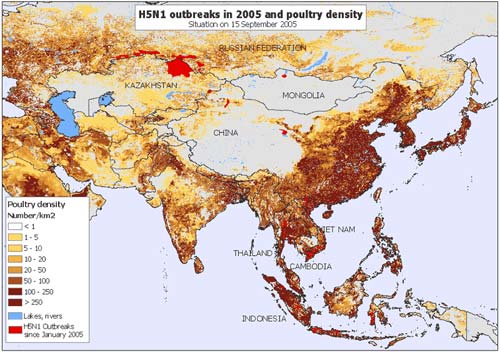FAO: H5N1 can cause domino effect
The Food and Agriculture Organization (FAO) is concerned about a chain collapse effect once there is a " gap " in bird flu surveillance in a certain country.
In a statement released on December 5, the United Nations Food and Agriculture Organization (FAO) fears that failure in any country that has ever had avian influenza has caused epidemics quickly. spread to many other countries.
That will create a domino effect that results in " all the good results in controlling the disease over time will be useless ".
FAO warns that the H5N1 strain of avian influenza virus is still a major threat, potentially causing a pandemic in humans and animals, especially in " sensitive areas " such as Southeast Asia, Africa, and East. Europe and the Caucasus region.
FAO said that there are many areas in the world still in a state of " particularly sensitive ", easy to outbreak of bird flu, so FAO will prioritize aid to these regions and countries. .
FAO also emphasizes the urgency of greater transparency in information sharing, especially on virus strains.
According to the World Health Organization (WHO), since the first outbreak in Asia at the end of 2003, so far the H5N1 virus strain has spread to Europe, Africa and the Middle East region, making 154 people worldwide died.
Many experts are still concerned that the virus strain can transform itself into a form that can easily spread from person to person and cause a pandemic.

Map of H5N1 flu in 2005 (Photo: FAO)
- The H5N1 variant can spread to humans through respiration
- H5N1 flu appears in poultry in Ninh Thuan
- Sell pizza on the Moon
- Pandemic H5N1 has returned
- Bad developments in H5N1 in Asia and Europe
- Detection of the H5N1 virus strain by a test
- 100% of people infected with H5N1 in 2009 died
- Cats infected with H5N1 virus?
- Two cases of death from H5N1 flu in Cambodia
- Restart studies of H5N1
- The first case of death from H5N1 flu in 2014
- Discover interesting psychological effects
 March 2012: Launching H5N1 vaccine for poultry
March 2012: Launching H5N1 vaccine for poultry Experts comment on the mysterious gradual disappearance of the Delta variant in Japan
Experts comment on the mysterious gradual disappearance of the Delta variant in Japan Danger of the two Delta . branch variants
Danger of the two Delta . branch variants 2020 pandemic flu attack humans?
2020 pandemic flu attack humans?